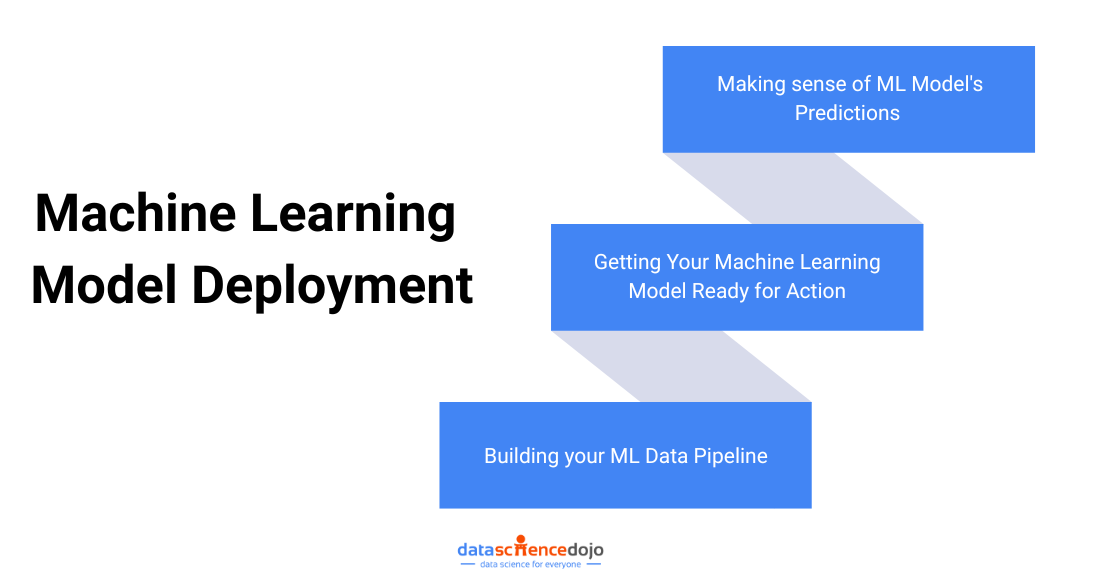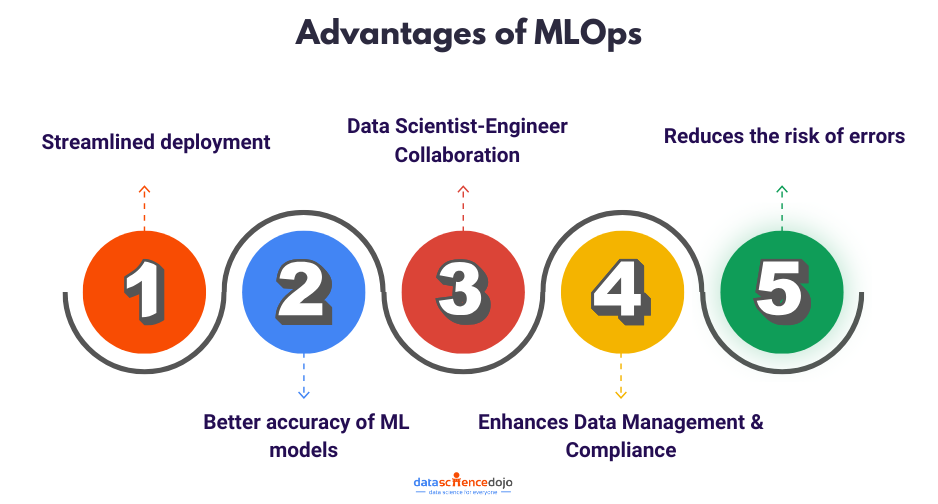Machine Learning (ML) is a powerful tool that can be used to solve a wide variety of problems. However, building and deploying a machine-learning model is not a simple task. It requires a comprehensive understanding of the end-to-end machine learning lifecycle.
The machine learning model deployment can be divided into three main stages:
- Building your ML data pipeline: This stage involves gathering data, cleaning it, and preparing it for modeling.
- Getting your ML model ready for action: This stage involves building and training a machine learning model using efficient machine learning algorithms.
- Making sense of your ML model: This stage involves deploying the model into production and using it to make predictions.
Machine Learning Model Deployment
Machine learning model deployment goes far beyond simply pushing a trained model into production. It involves a comprehensive workflow that includes preparing the data, building and training the model, and finally deploying it into a live environment where it can generate real-time predictions.
Each stage—data pipeline construction, model development, and operational deployment—plays a critical role in ensuring the model performs reliably and scales effectively in real-world scenarios.
Building your ML Data Pipeline
The first step of crafting a Machine Learning Model is to develop a pipeline for gathering, cleaning, and preparing data. This pipeline should be designed to ensure that the data is of high quality and that it is ready for modeling.
The following steps are involved in pipeline development:
- Gathering data: The first step is to gather the data that will be used to train the model. For data scrapping a variety of sources, such as online databases, sensor data, or social media.
- Cleaning data: Once the data has been gathered, it needs to be cleaned. This involves removing any errors or inconsistencies in the data.
- Exploratory data analysis (EDA): EDA is a process of exploring data to gain insights into its distribution, relationships, and patterns. This information can be used to inform the design of the model.
- Model design: Once the data has been cleaned and explored, it is time to design the model. This involves choosing the right machine-learning algorithm and tuning the model’s hyperparameters.
- Training and validation: The next step is to train the model on a subset of the data. Once the model has been trained, it can be evaluated on a holdout set of data to measure its performance.
Getting Your Machine Learning Model Ready for Action
Once the pipeline has been developed, the next step is to train the model. This involves using a machine learning algorithm to learn the relationship between the features and the target variable.
The following steps are involved in training:
- Choosing a machine learning algorithm: There are many different machine learning algorithms available. The choice of algorithm will depend on the specific problem that is being solved.
- Tuning hyperparameters: Hyperparameters are parameters that control the behavior of the machine learning algorithm. These parameters need to be tuned to achieve the best performance.
- Training the model: Once the algorithm and hyperparameters have been chosen, the model can be trained on a dataset.
- Evaluating the model: Once the model has been trained, it can be evaluated on a holdout set of data to measure its performance.
Making Sense of ML Model’s Predictions
Once your machine learning model is trained and validated, the real value begins to emerge—when it’s deployed to make live predictions. This phase, known as inference, is where your model starts generating insights from real-world data. Here’s a closer look at the key steps involved:
1. Deploying the Model
Deployment is the process of integrating your model into a production environment where it can start receiving and responding to requests. Depending on your use case, this could mean embedding the model into a web application, a mobile app, or a cloud-based service via APIs. Popular tools for deployment include Flask, FastAPI, Docker, and cloud platforms like AWS SageMaker or Azure ML.
2. Making Predictions
Once deployed, the model can now consume new, unseen data to generate predictions—whether it’s classifying emails as spam, recommending products, or forecasting sales. This step should be optimized for speed and scalability, especially if the application supports a high volume of requests.
3. Monitoring the Model
Deploying a model isn’t a “set it and forget it” process. Over time, data patterns can shift—leading to performance degradation. That’s why continuous monitoring is essential. By tracking metrics like prediction accuracy, response time, and input distributions, teams can detect issues like data drift, model staleness, or bias creep.
Incorporating observability tools and automated alert systems ensures that you can quickly identify when the model’s predictions are no longer reliable—and take corrective actions like retraining or updating features.
Conclusion
Developing a Machine Learning Model is a complex process, but it is essential for building and deploying successful machine-learning applications. By following the steps outlined in this blog, you can increase your chances of success.
Here are some additional tips for building and deploying machine-learning models:
- Establish a strong baseline model. Before you deploy a machine learning model, it is important to have a baseline model that you can use to measure the performance of your deployed model.
- Use a production-ready machine learning framework. There are a number of machine learning frameworks available, but not all of them are suitable for production deployment. When choosing a machine learning framework for production deployment, it is important to consider factors such as scalability, performance, and ease of maintenance.
- Use a continuous integration and continuous delivery (CI/CD) pipeline. A CI/CD pipeline automates the process of building, testing, and deploying your machine-learning model. This can help to ensure that your model is always up-to-date and that it is deployed in a consistent and reliable manner.
- Monitor your deployed model. Once your model is deployed, it is important to monitor its performance. This will help you to identify any problems with your model and to make necessary adjustments
- Using visualizations to understand the insights better. With the help of the model many insights can be drawn, and they can be visualized using software like Power BI.






